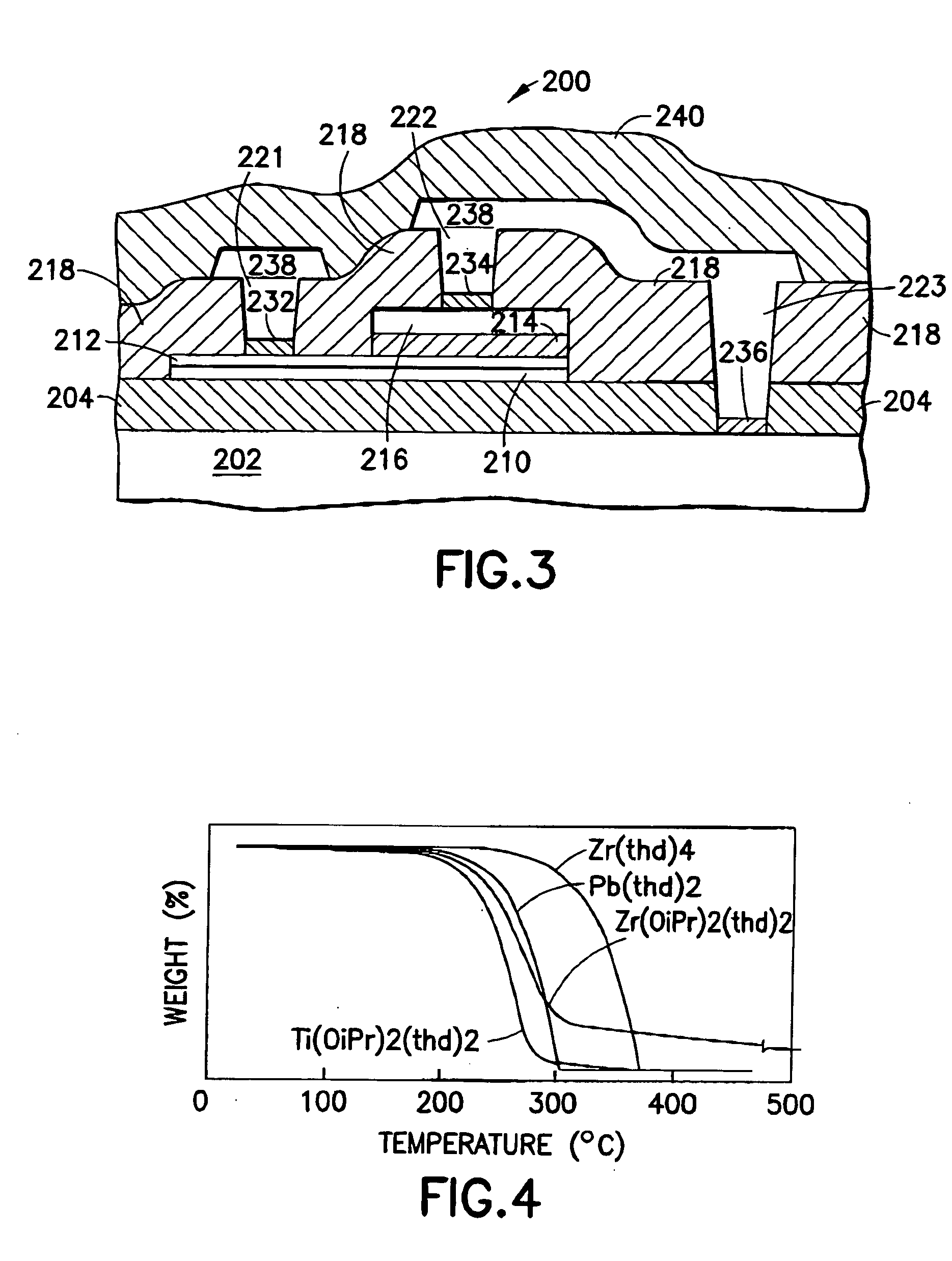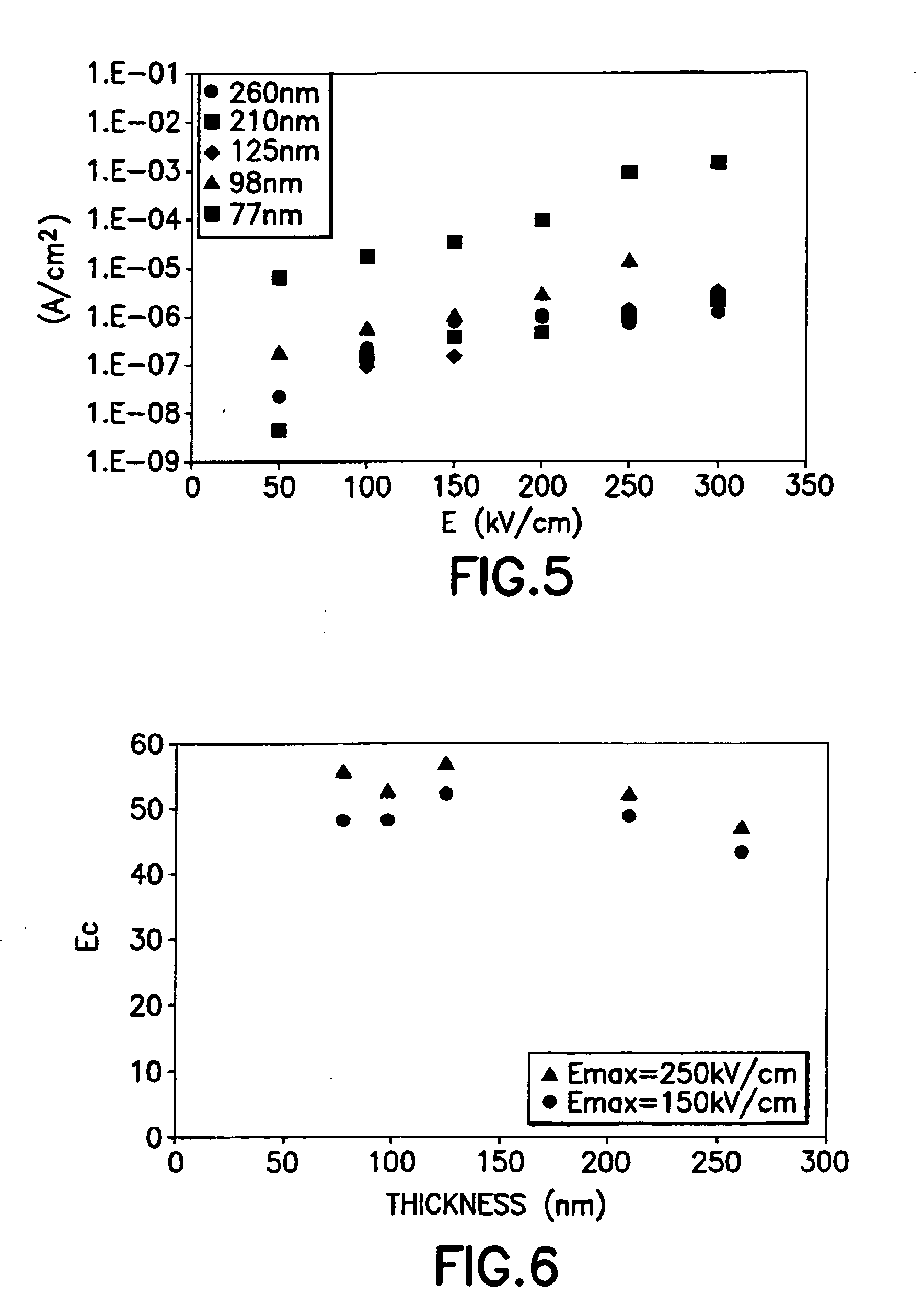Scalable lead zirconium titanate (PZT) thin film material and deposition method, and ferroelectric memory device structures comprising such thin film material
a lead zirconium titanate, thin film material technology, applied in the direction of thin/thick film capacitors, fixed capacitors, ceramics, etc., can solve the problems of low value of switched ferroelectric polarization, poor fatigue and retention of pt/pzt/pt capacitors, and inability to adapt to the environmen
- Summary
- Abstract
- Description
- Claims
- Application Information
AI Technical Summary
Benefits of technology
Problems solved by technology
Method used
Image
Examples
example 1
[0109] The lead precursor chosen was lead bis(2,2,6,6-tetramethyl-3,5-heptanedionate) [Pb(thd)2]. This compound has no appreciable vapor pressure at room temperature, which makes it much safer to handle than tetra-alkyl lead reagents. However, the low volatility of Pb(thd)2 (0.05 Torr at 180° C.) requires the use of liquid precursor delivery. Titanium bis(isopropoxide)bis(2,2,6,6-tetramethyl-3,5-heptanedionate) [Ti(O-i-Pr)2(thd)2] was used as the titanium precursor. Zirconium tetrakis(2,2,6,6-tetramethyl-3,5-heptanedionate) [Zr(thd)4] was used as the Zr source reagent. These compounds are extremely soluble in organic media and no possible detrimental ligand exchange occurs since the titanium atom is coordinatively saturated.
[0110] The following process conditions were applied:
Operating ParameterProcess ConditionSubstrate temperature550˜610° C.Bottom electrodeIr / SiO2 / SiTotal reactor pressure1˜10 TorrReactor wall temperature˜210° C.Carrier Ar flow˜200 sccmO2 flow500 sccmN2O flow500...
example 2
[0112] Solutions with a range of different Pb / (Zr+Ti) ratios were used over a series of deposition runs. This ratio is hereafter defined as (A / B)g, denoting the conventional assignment of Pb to the “A” site, and Zr and Ti each to the “B” site in the perovskite cell, ABO3. The subscript g denotes the gas-phase concentration in the reaction chamber, while (A / B)f denotes the equivalent ratio in the film.
[0113] The gas phase ratio of Zr / (Zr+Ti) was held constant at 0.612. Under the conditions given above in Example 1 and for the specific CVD reactor employed, the gas phase ratio of Zr / (Zr+Ti)=0.612 resulted in films with Zr / Ti˜40 / 60, which for bulk materials yielded a tetragonal crystal structure and ferroelectric properties. This is a common composition chosen for FeRAM applications because of its high Pr and the relative ease in forming the perovskite phase for lower Zr / Ti ratios.
[0114] Next, a series of PZT films was deposited with fixed deposition time, under the process condition...
example 3
[0123] A central-composite-design experiment was used to probe a large volume of process space and assess interactions between principal process variables. Deposition temperature (550, 575, 600° C.) and pressures (500, 1750, 3000 mTorr) were independently varied at five different values of (A / B)g: (0.53, 0.73, 0.93, 1.13, 1.53). A constant deposition time of 1660 seconds was used.
[0124] Compositionally, a plateau onset in (A / B)f was observed at (A / B)g=0.93. For a given pressure, film lead content was observed to decrease with increased deposition temperature. Furthermore, incorporation efficiencies of both lead and titanium decreased with increasing (A / B)g for all temperatures.
[0125] Electrically, the best samples arose from the conditions at the center of the design (575° C., 1.75 Torr, (A / B)g˜1). Most of the good samples displayed a (−) voltage offset. There was no appreciable center-to-edge (wafer) effect. Leakage seemed to behave better for lower Pb and for thicker samples (˜1...
PUM
| Property | Measurement | Unit |
|---|---|---|
| temperature | aaaaa | aaaaa |
| pressure | aaaaa | aaaaa |
| area | aaaaa | aaaaa |
Abstract
Description
Claims
Application Information
 Login to View More
Login to View More - R&D
- Intellectual Property
- Life Sciences
- Materials
- Tech Scout
- Unparalleled Data Quality
- Higher Quality Content
- 60% Fewer Hallucinations
Browse by: Latest US Patents, China's latest patents, Technical Efficacy Thesaurus, Application Domain, Technology Topic, Popular Technical Reports.
© 2025 PatSnap. All rights reserved.Legal|Privacy policy|Modern Slavery Act Transparency Statement|Sitemap|About US| Contact US: help@patsnap.com



